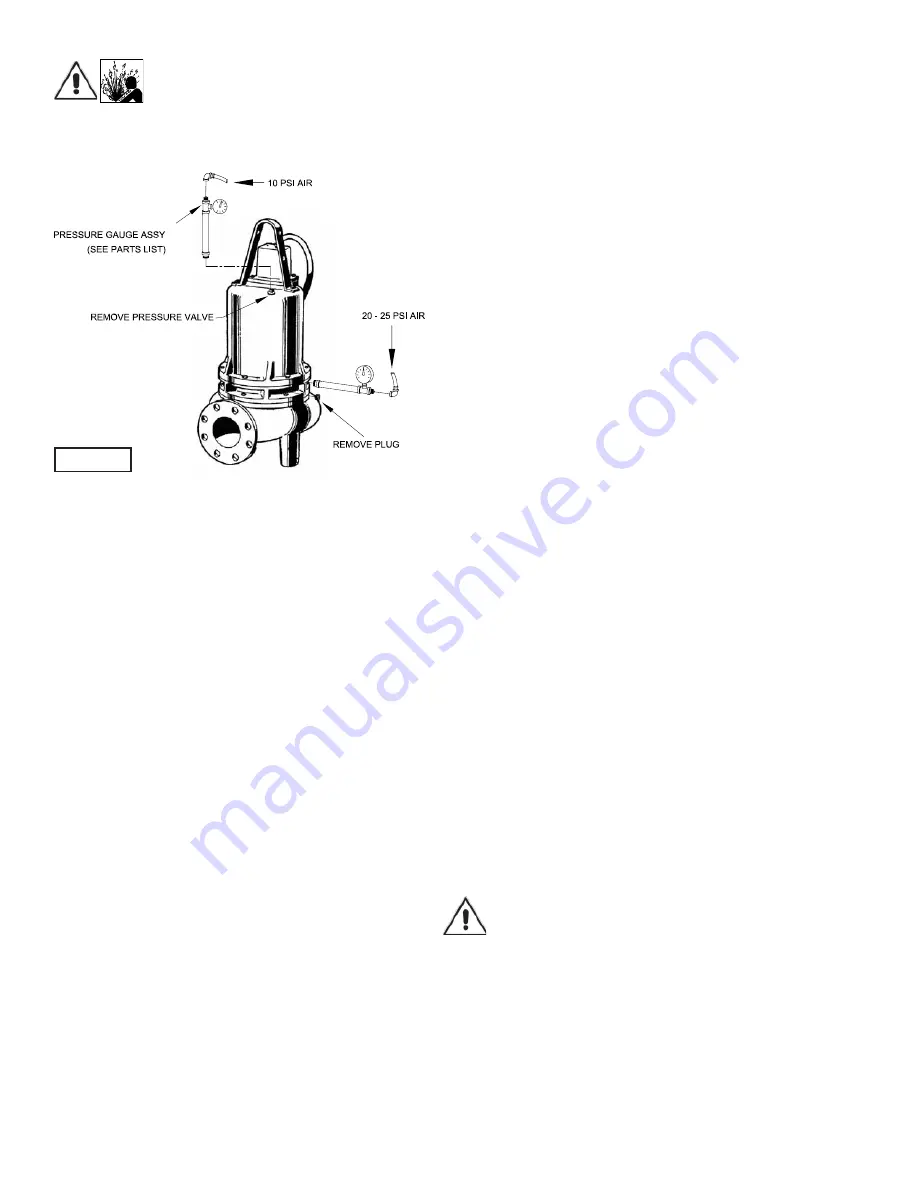
8
Caution! - Pressure builds up extremely
fast, increase pressure by “tapping” air
nozzle. Too much pressure will damage
seal. Do Not exceed 10 P.S.I. in motor
housing & 20-25 P.S.I. in seal chamber.
F-1.4) Pressure Test:
Motor Housing -
Before checking the pump for leaks around
the shaft seal, square rings, and cord inlet, the oil level should
be full as described in section F-1.3. Remove pressure valve
(5) from motor housing (2). Apply pipe sealant to pressure
gauge assembly and tighten into pressure valve hole (See Fig.
2). Pressurize motor housing to 10 P.S.I. Use a soap solution
around the sealed areas and inspect joints for “air bubbles”. If,
after fi ve minutes, the pressure is still holding constant, and no
“bubbles” are observed, slowly bleed the pressure and remove
the gauge assembly. Replace the Pressure valve using a
sealant. If the pressure does not hold, then the leak must be
located.
Seal Chamber -
Remove pipe plug (22) from Bearing Bracket
(21) and check that seal chamber is full of oil. Apply pipe
sealant to pressure gauge assembly and tighten into hole in
bearing bracket (21). Pressurize seal chamber to 20-25 PSI
and check for leaks as outlined above.
F-2) Impeller and Volute Service:
F-2.1) Disassembly and Inspection:
To clean out volute (26) or replace impeller (28), disconnect
power, remove hex nuts (20) and vertically lift motor and seal
assembly from body (26). Clean out body if necessary. Clean
and examine impeller (28), for pitting or wear and replace if
required, inspect gasket (41) and replace if cut or damaged.
If the impeller (28) requires replacing, remove cap screw (34)
and washer. The impeller is keyed onto the shaft with a square
key (33) and to remove, pull impeller straight off the shaft using
a wheel puller, if required. Before reinstalling, check the motor
shaft and impeller bore for damage.
F-2.2) Reassembly:
To install impeller (28), apply a thin fi lm of oil to motor shaft
and slide impeller straight onto shaft, keeping keyways lined
up. Drive key (33) into keyway.
Locate washer, Apply thread lock primer (such as Loctite®
Primer T) let set per manufactures’ directions. Apply thread
locking compound to cap screw (34) threads, thread cap
screw (34) into shaft and torque to 35 ft. lb. Rotate impeller to
check for binding. Position gasket (41) on volute fl ange and
install impeller and motor housing over studs and onto volute
(26). Apply thread locking compound to threads of each stud
(24). Thread nut (20) onto stud (24) and torque to 24 ft. lb.
Check for free rotation of motor and impeller.
F-3) Motor and Bearing Service
F-3.1) Disassembly and Inspection:
To examine or replace the motor (1) and bearings (3) and
(47), disassemble pump, volute and impeller (as outlined in
paragraph F-2.1) and disassemble seal plate and shaft seal
(as outlined in paragraph F-4.1). Drain oil from motor as out-
lined in paragraph F-1.3.
Position unit upright, using blocks to avoid resting unit on
shaft. After removal of cable and box assembly (10) from
motor housing (2), remove cable lead wires from motor
lead wires and moisture and temperature sensors wires (if
equipped) from control cable by unscrewing connectors (12)
and (17). The wiring connections should be noted to insure
correct connections when reassembling. Remove cap screws
(19) and hex nuts (20). Vertically lift the outside motor hous-
ing (2) from bearing bracket (21) with lifting strap (7). Inspect
square ring (42) for damage or cuts. Remove the upper motor
bolts and lift upper end bell from motor (1). Examine upper
bearing (3) and replace if required. If replacement is required,
remove bearing (3) from motor shaft using a wheel puller.
NOTE SPECIAL BELLVILLE WASHERS
in upper motor
housing required to compensate for shaft expansion. These
Bellville washers and spacer shims (9) and (29) must be
properly reinstalled to give the required constant down force
on the motor shaft. See Section F-3.3.
Vertically lift stator. Inspect winding for shorts and resistance.
To test the temperature sensor (if equipped), check for continu-
ity between the black and white wires. If found to be defective
contact a motor service station or Crane Pumps & Systems
service department. Pull motor rotor and lower bearing (47)
vertically from bearing bracket (21). Examine bearing (47) and
replace if required. If replacement is required, remove bear-
ing (47) from motor shaft using a wheel puller. Check rotor for
wear. If rotor or the stator windings are defective, the complete
motor must be replaced. While disassembled, check moisture
sensor wires (16) (if equipped), that they are secured to elec-
trodes (18) with lockwashers (15) and screws (14).
Important !
All parts must be clean before reassembly
.
F-3.2) Reassembly:
Bearings -
When replacing bearings, be careful not to damage
the rotor or shaft threads. (If so equipped, fi ll notch should face
the rotor core for both upper and lower bearings). Clean the
shaft thoroughly. Apply adhesive compound to the shaft and
press bearing (47) on the motor shaft, position squarely onto
the shaft applying force to the inner race of the bearing only,
until bearing seats against shoulder of the shaft. Reassemble
top bearing (3) in the same manner.
FIGURE 2








































